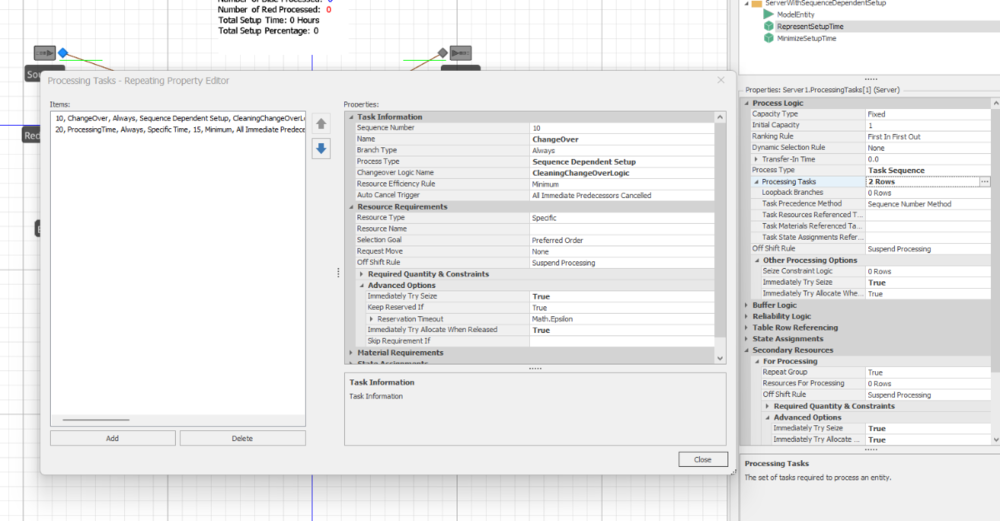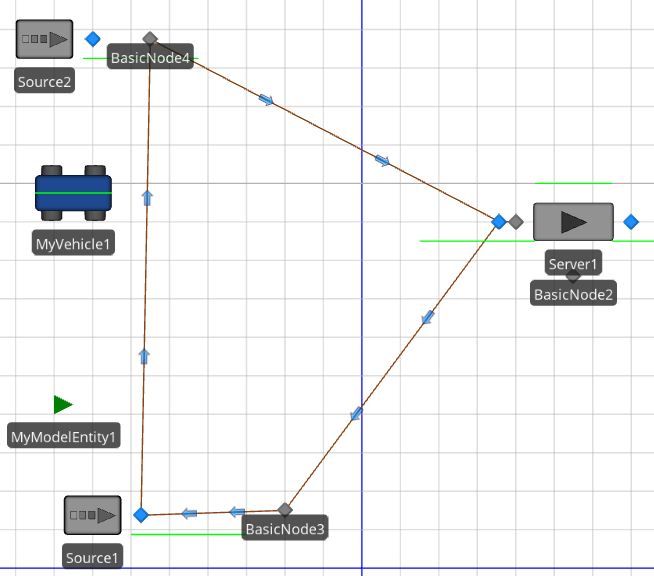Search the Community
Showing results for 'the maximum number in system limit for entities of type exceeded'.
-
Before you start adding state variables to a library object, I suggest that you first familiarize yourself with all of the existing states. One easy way to do this is to instantiate the object (e.g., Worker1) and then go to any expression field and type "Worker." and look at the list. In the case of Worker, there are over 100 states, functions, and properties built-in to the Worker object. Another way is to subclass the Worker, then go to the Definitions tab of the MyWorker object and you can see all of the built-in definitions by category: There is a pretty good chance that what you need is already there. But if not, use the same screen illustrated above and add whatever state (or property, event, ...) that you need. As far as referencing or assigning that custom state or a built-in state, it is done using ObjectName.StateName. For example if you added a state named TimeStartedMove to MyWorker, and you wanted to assign that value, you might assign MyWorker.TimeStartedMove to TimeNow. The tricky part, especially with more complex objects like Workers, is to determine exactly when/how to assign that value. Sometimes you can interact with the model itself to insert an Assign at the correct location (let's say in the Loaded Add-on Process). Or sometimes you might need to override the process logic in your custom object. The SimBits RecordDistanceTraveled and ElectricVehicle are examples to review.
-
Hello everyone, I have a server which can potentially have many entities waiting in the input queue. All these entities have different priorities (as a model entity state variable). I want to retrieve these values to then select the highest one and put it on a status label to track this during the run. Is there an option to do this? Regards, MF
-
Thank you for the quick and detailed response! I see the error I was making with work schedule and have tested it on one server, it seems to work as intended. Since each of my servers have a different capacity, would I need to create a unique work week and unique day type for them all? Or is there a quicker work around? The manual inputs for the date time are a great work around, I'm only modeling for a few years so I don't mind inputting a few dates. What I mean by there being no buffers is that no server can have a queue. I used a list for selecting the destination on the output node of each source (total of 8 ) where it's a hierarchy. It can go to a select number of servers and if all of them are full it goes to a dummy server of infinite capacity that exits the items to an overflow sink.
- 2 replies
-
- server
- work schedules
-
(and 2 more)
Tagged with:
-
You want to make the servers have a Capacity Type of Schedule and follow the default Standard Week. If you don't want to give them a lunch break, just change the definition of the Standard Day. Leave the default Off Shift Rule of Suspend Processing. The easiest approach for arrivals is to have a Source with an Interarrival time of 4.33 weeks (or 4 weeks) and an integer random distribution for the Entities Per Arrival. Doing a "first Monday" is possible, but a bit complicated because Simio time does not have the concept of Month because months are of varying size. You could probably specify the initial Time Offset to be early in a month, then maybe make the interarrival time be something like DateTime.DaysInMonth(DateTime.Month(Timenow),DateTime.Year(TimeNow)) which would make the next arrival be exactly one month later (same day of the month). When you say you have no buffers, what do you mean? If an entity arrives when all servers are busy, should it be balked (possibly disposed) or should it wait somewhere like on the server input node, on a path or in the Source output node? If the above arrival approach isn't exact enough, you can put exact arrivals in a data table. The arrival time could be specified at any exact datetime you desire and still have the Entities Per Arrival be a distribution.
- 2 replies
-
- server
- work schedules
-
(and 2 more)
Tagged with:
-
Hi all! I am simulating a facility with nearly 40 servers, each one starting with some entities in the input node at initialization and having a different capacity. Each server has a 0 input buffer capacity. My entity creation is currently set to having an interarrival time to be 4.33 weeks (1 month) with a random number of entities created. Currently, it runs 24/7 and does not care about the time, but I want to incorporate that. How can I make it so that the entities arrive once a month, let's say the first Monday, at 8am? How can I make it so the servers are only processing between 8am and 4pm Monday - Friday? The work schedule doesn't seem to work for me, but I could be doing it wrong, since I have a 0 input buffer, which I can't change as it's part of my routing logic for overflow. I would be happy with using timers or a process logic if someone can explain it to me. Ideally, the entities only arrive when it's during the working time, and the entities remaining after 4pm are just put on hold until 8am the next day. Thanks in advance!
- 2 replies
-
- server
- work schedules
-
(and 2 more)
Tagged with:
-
Define a new property for a certain object
jzhou replied to Marcel Favereau's topic in SI General Discussions
Did you create an object-reference type of properties? -
Hello everyone, I am trying to add a new property for a Server object, which would be a string. For instance, the property needs to be something like "Type of Patient" (that each server can attend). I created a property within the Server's subclass, but it does not work. ¿How can I define a new property for a certain object? Thanks in advance, Marcel Favereau
-
Hi, there is a simple approach you can use. Use Connectors between the queue server and the desks. At Buffer Logic of the Desks, change the Input Buffer Capacity to 0. Create a List with the Input nodes of the seven Desks. On the Output of the queue server change Entity Destination Type to Select From List and the goal to Smallest Value. Keep the default expression. It should work fine.
-
Hello all I am relatively new to Simio and DES. I am trying to model a pallet conveyor. It is a closed loop conveyor. I use the "vehicle" as the pallet that loops around the conveyor. At the source the part (default entity) is loaded on the pallet. At the sink the part is unloaded. The problem that I am encountering is that the vehicles from time to time pile up at the sink, then after a certain amount of time they continue back to the starting point "Source1". This happens more the more I increas the "initialnumber in system" of vehicles The transfer-in Time for the sink is set at 0. At the model trace I read this for the "Input@Sink1" : "the in Token waiting at VisitNode step for '1' other processes to complete." I would apreciate any advice. Many thanks! Vehicle_stuck_at_sink.spfx
-
Hello everybody, I'm trying to make this work but I cant Type/Conteiner BinBig BinMed BinSmall Product1 1 1 - Product2 - 1 1 Product3 1 - 1 Product4 1 1 1 I want to make a node where these entities (Products and Bins) are convined in one batch, I try to use a process based in decitions and search.. the file is attached if you wanna take a look on it.. (the product have to be the parent) OptimoContenedores2.spfx
-
Hi, it creates a token for each row that matches the condition (given that you did not limit the search). You can access it using TableName.ColumnName.
-
Hi there, I'm very much a novice, but currently leveraging the logic in VisitAllServersInAnyOrder simbit to ensure an entity visits an entity is never reworked more than once. I've updated the model entity with required state variables and created a "MyServer" to create the "HasEntityVisited" etc etc. I'm using the "Candidate.MyServer.HasEntityVisited==False" logic for the selection condition in the output node routing logic. However, whenever I run the model I get the error message "Referenced definition type "MyServer" does not match executing type "BasicNode". I've gone over and over the various elements and compared to the working simbit, but can't identify the issue. Any help would be greatly appreciated. Thanks in advance. Garrett
-
I know it's been a while, but I just came across this question and I'm responding in case this can help someone else. Depending on the problem, modeling nurses as patient capacity might not work; for example, if you need to limit both a nurse's active utilization and the nurse's patient load. Two general approaches exist: Easier: Create two different resources, rename one 'NursesActive' and the other 'NursesPassive.' Set the latter to have n times the capacity of the former, where n is the patient ratio at n:1. Require simultaneous seizure of one of each type of resource when first assigning the patient, and release them separately, re-seizing the former as needed. Harder: Subclass the Resource object and create states to track the patients assigned and a property to define the patient ratio. This approach enables more fine-tuning as necessary.
-

Changing Sequence table over time
Rebecca Obasi replied to antonio6vieira's topic in SI General Discussions
I used the "DashboardForScheduling" simbit as an example for this case. For the order that is using "FinishedGoodA" material, I want to change the sequence after the welding process is complete if both shape stations are not available. So, I created an alternative sequence table and referenced in the process logic I created. Whenever this happens, I get same type of error message. Do you think this is happening because the normal routing table is referenced at the source object? -
Rotary filler head object: Can be used in liquid/powder filling operations
deod replied to deod's topic in SI Shared Items
Updated version with prime on infeed. Filler won't start until you have enough entities on the infeed conveyor. IndexingPlate - V4.spfx -
Rotary filler head object that represents animation of bottles rotating around a cylinder as they get filled. You can use a regular server if animation is not required. This object lets you define the number of filling heads, direction of rotation and rate (Bottles Per Minute), pitch of fillers heads (in degrees) and ReleaseType (Release type represents where the bottle will be released at 180 Degree from the start point or 270 degree). As seen in the picture above, Arrow represents the starting point. Users can also specify if they need fine control over the rotation of the filler heads. If fine control is set to True filler head will pitch by 1 degree. This provides smoother animation.Users will have to make sure the pitch is set correctly in relation to the release type if Fine Movements are set to False. With FineMovements set to False filler heads movement is equal to pitch defined. Users can also specify failure rate in similar way to server or other standard Simio objects. This object has not been extensively tested and it can be further customized to requirements. IndexingPlate - V4.spfx
-

Changing Sequence table over time
Rebecca Obasi replied to antonio6vieira's topic in SI General Discussions
Ok I can do a trace and see what I find. Also, I do have different entity/job types getting processed. In my routing tables, I do have the entities specified in the table. I'm trying to use the "ChooseAlternateSequence" simbit as a reference. Is it possible to do this if you have more than one entity type? -

Transferring properties between objects
MauricioBiolato replied to FoodEngFAAB's topic in SI General Discussions
Hi Fabian, I see two (or more) possible alternatives for solving this. Assuming that the box only receives one type of entity you can: 1. Create a state variable (for example st_CurrentBoxType) and every time an entity enters the combiner you assign the entity type to this state variable. This way, one the box is completed and exits the combiner you will be able to assign it the st_CurrentBoxType. 2. The other way is to execute a search step once the box is full. You can use "ModelEntity.BatchMembers.FirstItem" as match condition to locate the first batched entity, then in the found branch use an assing step to assign the ProdType from the found entity I'm sure there are a lot of ways of doing that... hope this helps saludos -
Hello everyone: I am modeling a packaging system by means of a combiner. 12 equal members are grouped in a box (parent). Before leaving the respective source, members are assigned a value (0, 1, 2) as a state variable (ESV_P) to distinguish them by product type. I want the box to have the value of the products state variable. For example, if the box contains 12 type 1 products, the box should be assigned with a state variable ESV_B equal to 1. Any suggestions? Best regards.
-
Perhaps its a little late, but attached is a possible solution to your problem. This started out pretty simple. The problem was how to specify which server is serviced by which resource. One way to do that is a table. But since its changing over time I chose to use a time-indexed table, that is a table that knows about time and returns different data at different times. In this case, each row corresponds to 12 hours and each column specifies the resource needed by the respective server. As they say, "the devil is in the detail" and in this case the "devil" is that the specified resource may change between seize and release (e.g., seize at 11:59, release at 12:05). Simio doesn't like that and all the easy options re-evaluate the resource expression on release and so may try to release the wrong resource. One option would have been to create a custom server, but that seems to be overkill. Here is a somewhat simpler approach: 1) Add an entity state named MyResource and assign it at the last possible moment before use. This value will be used only for release. The assigned value is drawn from the table using an expression like Table1.S1Resource.TimeIndexedValue.Object. Note that the .timeindexedvalue indicates to get the value associated with the current time. And the .object at the end is used to tell Simio to return that value as an object not a number. 2) Use Secondary Resources - Other Resource Seizes to seize the name specified in the table using the same expression above Table1.S1Resource.TimeIndexedValue.Object. 3) Use Secondary Resources - Other Resource Releases to release the resource saved in MyResource. TimeBasedWorkerSelection.spfx
-
Hello, I'm having strugles trying to configure the setup for the next process: some entities have a diferent processing time and setup time, before to enter to be processed in the workcenters, the workcenter have to be cleaned. I looked the simbit, "ServerWithSequenceDependenrSetup" but I'm confused with the configuration of the processing task. I dont know why we have two lines and o why only one have associeted the change-over matrix.
-
Hello there, this is my first post here and I hope someone can help me with my problem. I´m quite new to Simio and working on my first project. I have some "return entities" that are considered "bad" at the end of the production. So they will get collected in a server which is used as a storage and get returned to the factory every 24 hours, to get reworked, if there is capacity left. Now, I want to check if there is capacity left in the destinated server and in best case, reserve the needed capacity before, before I route these entities towards it. After the entity arrived in the server, the reserved capacity should get released again. I couldn´t find a good example here in the forum or via google search, as in the SimBits, how to solve this the correct way. Maybe someone here can give me a tip, how to. Thanks in advance. Aljonator
-
hello :), I'm trying to make a model with three servers. Everyone uses different Workers type and have different operation time per entity (no problem in these points). The difficult part is the next, every work center (server) has a different setup and changeover, and both happens without the presence of the entity. I mean the setup of some servers starts when the entity is created, (before the arrival to that server), and after the operation the changeover has to be done, in both cases we need to use or assing a worker. How can I do that?
-
Hello, I have two concerns. In one of my small models I want my transporter to make a round and pick up the entities at the different locations and bring them to a destination (Server1). In addition, I would like that the individual times are measured with a state MyModelEntity.TmpStart and MyModelEntity.Duration, in order to calculate afterwards with a transport cost rate the cost for each individual part. Unfortunately I'm getting desperate with this and getting various error messages, does anyone know how to implement this? Best Regards, Gashi
-
Referenced definition type and executing type error
Gashi replied to Gashi's topic in SI General Discussions
Thank you for the quick answer! But i get the same error type when using MyModelEntity instead of MyVehicle. Referenced definition type "MyModelEntity" does not match executing type "MyVehicle". In the Transport Logic of the Output@Source1 (Properties), i have the MyVehicle as a transporter. It seems like both of them are executing the add on process trigger...












